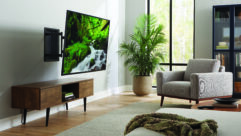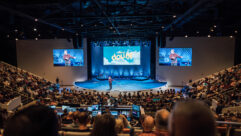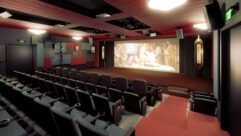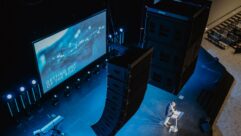Every Seat’s the Best Seat
Mar 1, 1996 12:00 PM,
By Charles Conte
There is an old joke about an usher who lined his pockets by ceremoniously leading patrons to a seat as if it were a great honor and, on being queried as to which seat was the best in the house, always answered, “Why, the one you’re in, sir, of course!” At Ottawa’s National Arts Centre’s opera hall, which just received a new loudspeaker cluster, that gentleman could make a killing. Even seats that simply could not be covered with the old sound system suddenly are some of the best seats in the house from an audio standpoint.
Of its three performing halls, the majestic 2,300-seat opera hall is the largest, hosting concerts by the resident NAC orchestra, under the artistic direction of Trevor Pinnock, and numerous and varied musical acts.
Renovation of the entire NAC sound system, a project so large it played out over three years and in three distinct phases, reached another benchmark in August of last year with the raising of the opera’s center loudspeaker cluster system.
The opera center cluster comprises four EAW MH660E mid- and high-frequency horn systems with two BV525PD2 matching low-frequency systems with two 15 inch (381 mm) direct-radiating woofers each. The loudspeakers are powered by two Crest 3301s, two model 6001s and one model 8001. An EAW MX300 controller, a MX200 controller, a BSS Varicurve equalization system and a BSS digital delay unit complete the cluster.
The heart of the entire opera sound-reinforcement system, these loudspeakers are used anytime anything is amplified in the hall and used on their own in conjunction with the opera delay system for preshow voice announcements. Though rarely used for “serious” music concerts, the house system plays a prominent role in the NAC’s pops series of concerts where vocalists, backed by the symphony, perform with their own rhythm section on stage in front of the orchestra. In such instances, certain sections of the orchestra may be miked to balance off with the individually miked instruments of the performer’s own players.This new installation joins the opera’s small flying and deck systems and opera delay system already in service in the hall. All of the opera hall systems are under Crest NexSys computer control.
The final phase of the renovation will be the installation of the opera’s large system comprising two each Crest model 4601, 7001 and 8001 amplifiers, powering eight EAW KF850 three-way, full-range loudspeaker systems with two MX800i CCEP crossovers. This concert flying rig is scheduled for installation sometime in March.
When the entire renovation project is complete, the federal arts complex will have 43 amplifiers from Crest Audio powering 60 EAW loudspeakers and 24 EAW closely coupled electronic processors. Crest’s NexSys 3.0 system will provide computer control for the entire sound system in the opera hall.
Getting it up thereReplacing the old loudspeakers with the new EAW-Crest system took nearly two weeks in August. Although the hall is a large venue, the actual enclosure for the center loudspeakers is quite limited, which made for quite a complex install.
“A decorative enclosure,” as Robert Allan, NAC’s head sound engineer, described it, “essentially a 46 foot-wide box that hangs at the top of the proscenium, 28 feet (8.5 m) from the floor, at minimum height. The loudspeaker systems have to be hidden behind a grille in this enclosure.”
Dale Fawcett of Orchestral Arts in Toronto, the acoustic design consultant for the central loudspeaker installation, drew a precision frame in AutoCAD with hanging points drilled before installation.Removing the old loudspeakers and replacing them meant erecting a scaffold that was 30 foot (9 m) high from which to work. After Allan’s team opened the decorative enclosure, they had to cut away the old support members with a cutting torch. The engineering staff designed a grid to reinforce the structure so it would carry the equipment. The grid, which has three 5’x5′ (1.5 mx1.5 m) steel members welded into place to brace the enclosure, were fabricated on-site in the scene shop. The loudspeakers were then hoisted to the scaffold platform one at a time and hung into place.
A few surprises, all pleasant”For the most part,” said Allan with reference to the sonic performance of the new loudspeakers, “it was a surprise to me because the sound was so radically different from what we were used to.” It took a few weeks of concert performances for Allan to become comfortable with the new system.According to Fawcett, the most pleasing aspect of the new sound system is the fact that only three EAW MH660E systems were required to cover 2,000 seats.
“That’s a real accomplishment: the N factor – acoustic energy of all three main loudspeakers compared to the same measurement at a particular location of only one loudspeaker – is very favorable,” Fawcett said. “The predictive ‘%Alcons with fade’ in EASE produced similar time vs. energy results in a hall already renowned for opera. The level of the fourth MH660E, a downfill covering about 300 seats, can either be set to taste or removed altogether.”
Coverage is better than ever, according to Allan, especially in the box seats on the sides, which could not be covered with the old system.
Resolving the problem of poor coverage in those surprisingly popular, top-level front box seats was a priority for Allan. The boxes receive sound from the new loudspeakers, but because of the extreme left and right angles, the team also hid a pair of KF300 loudspeakers on either side of the proscenium. As a result, these seats are now some of the best seats in the house sound-wise, according to Fawcett.
Another happy surprise for Allan, and one that tricked him a bit at first, is the complete low-distortion aspect of the system. “When I first started working with the system, I’d set a level I thought was comfortable,” Allan said. “But during the sound check, I had the sensation that the SPL was building up. When I would go out into the hall to measure the level, it would typically be 6 dB to 9 dB higher than I would have guessed.”
With the old system, Allan said, “you could always tell when you were up around 98 dB to 100 dB. I realize now that we must have had a fairly high distortion figure with the old system. With this system, you can’t tell. It goes up to 109 dB to 110 dB before you start to feel it.”
Fawcett said that with the EAW MH660 loudspeakers and Crest 3301-6001 amplifier package, concerns about adequate level don’t materialize. “You’re not always able to correlate distortion with level,” he said. “Sometimes it’s surprising to compare perceived loudness with a slow C-weighted sound-level meter while walking the venue.”
Some slap as predictedFawcett, whose work on the central loudspeaker array design began in spring 1993, had produced an acoustic model of the 800,000 ft3 (22,640 m3) multisurfaced opera hall using EASE software. The program had predicted some slap off the second and third balcony faces, but neither Allan nor Fawcett knew how much of a problem that might really be. On the older designs, they had split the hall in half with the horns aimed into the farthest corners of the room; none of the horns fired straight on. With the new system, when the orchestral shell is in place for the symphony, sound slaps off the balcony faces and returns about a quarter of a second later.
“In critical installations, it’s not necessary to model late reflections because you know these will find their way to the mix position,” Fawcett said. “In the opera, the three balcony faces are planes perpendicular to the stage floor. With the orchestra usually seated quite forward in the hall and its acoustic shell surrounding the musicians, the latter catches the high middle balcony reflection. During pops concerts, the solution is either to diffuse the sound off the balcony faces or perhaps, better still, redesign the orchestra shell using quadratic diffusers. These could significantly improve on-stage ambiance and diffuse sounds into the hall but also scatter specular reflections originating from the central loudspeakers. A new shell is easier to implement.”
On Fawcett’s last trip to the NAC, he and Allan tried draping some moving blankets over the balcony faces and found even that minor change made a tremendous difference.
Computer controlIn addition to the NexSys Load Monitoring feature, whereby Allan can verify the integrity of the loudspeakers 40 feet (12 m) in the air, NexSys provides complete gain control of the individual loudspeaker systems – both on the fly and as repeatable settings.In January, Paul Shiner, Crest’s manager of engineered systems, and Jerry Placken of White Radio Limited in Burlington, Ontario, visited the National Arts Centre to upgrade the NexSys system to version 3.0.
All road shows that come through the NAC with their own public address systems always give the NAC a feed for the house system because it is difficult to rig their portable systems high enough to give coverage to the upper balcony. If they don’t want to use the center down-horn, the NexSys system allows Allan to sit at the console and reduce the gain or even eliminate that loudspeaker. Similarly, if sound engineers for a visiting show think the two low-end cabinets are giving them too much low-end build-up in the balcony, Allen can reduce those low-end systems 3 dB to 6 dB from the console.
Allan takes “snap shots” in the NexSys system of everything done for a tour so that, when a show returns to the hall, he can give it exactly the same settings it used the first time. In this respect at least, NexSys and the opera’s new system will accrue more and more benefits for Allan and the opera hall as the touring season progresses.









